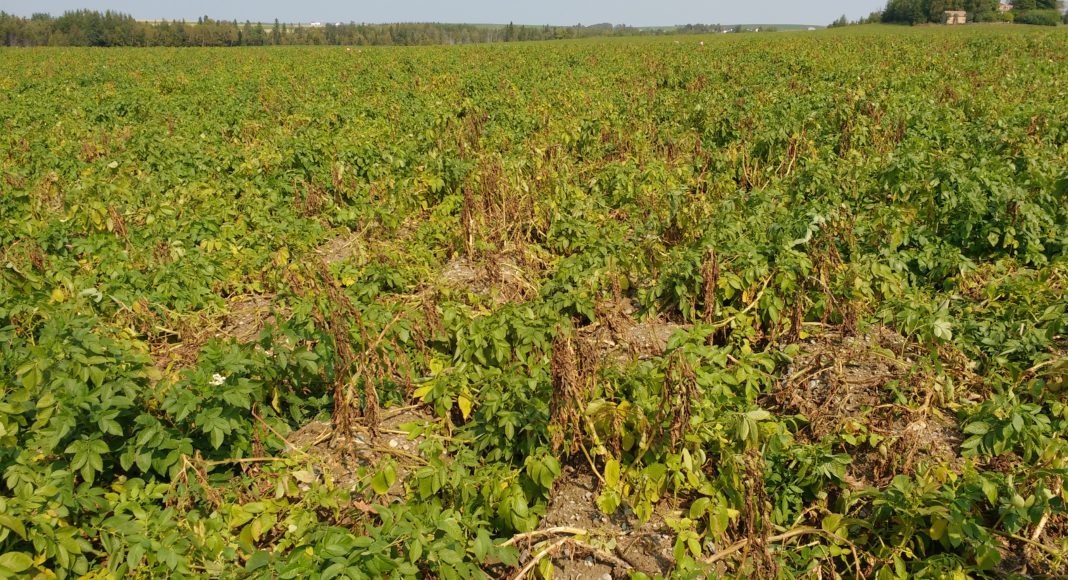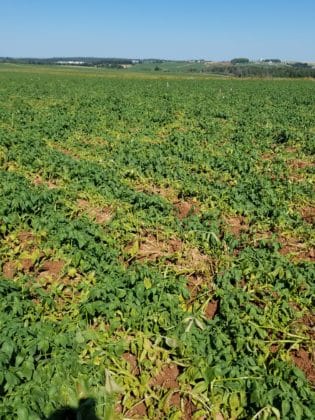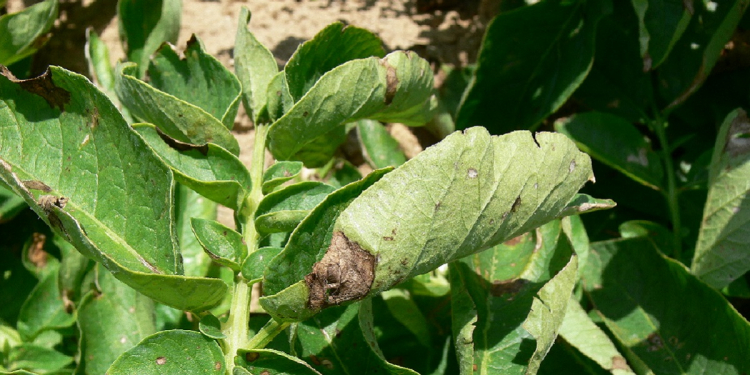Two years ago, a team of potato scientists and researchers from across Canada launched a comprehensive study aimed at reducing the impact of Potato Early Dying (PED) disease — a long-established yield robber which has become an even bigger headache for growers in recent years.

“This disease is widespread in most potato growing areas in Canada. It is a big concern to commercial potato producers as it impacts marketable yield,” says Khalil Al-Mughrabi, a pathologist at the Potato Development Centre with the New Brunswick Department of Agriculture, Aquaculture and Fisheries, who is also one of the researchers working on the PED project.
Dubbed the Canadian PED Network or CanPEDNet, the project is slated to continue for another two years, but there are already some things coming out from it which growers can get excited about. These include:
- The prospect of a much faster method for identifying and quantifying PED pathogens in the field
- The establishment of region-specific thresholds for applying PED control products
- Direction on the best cultural practices that growers can use to complement and strengthen their chemical control strategies
Mario Tenuta, a soil science expert at the University at Manitoba, is the project lead for CanadaPEDNet. CanPEDNet involves dozens of researchers from the public, private and university sectors and is supported by numerous grower and industry organizations. “It’s a very important issue. We really do need to get ahead on this disease, and we need to increase our potato yields as well. I feel really good about the project in terms of what we’ve been able to accomplish, especially considering COVID-19,” explains Tenuta.
Tenuta says the impact of pandemic has been particularly acute in the area of testing and analysis, as many of the laboratories participating in the project have been operating at a reduced capacity. “We’ve been able to still continue with the field work, which has been fantastic,” he adds. “I’m really looking forward to this coming year, because I think we’ll be able to get laboratory work in as well field work and be able to process a lot of the analysis over the fall and winter.”
What is Potato Early Dying?
Potato Early Dying is actually a complex of diseases, primarily Verticillium wilt, but also associated with nematodes and possibly black dot, which affect potato yield and quality by causing early senescence and death.
One aspect of CanadaPEDNet research is surveying soils from potato fields across the country to identify and measure pathogens and pests associated with PED. Tenuta says the research shows PED is mainly caused by the fungus Verticillium dahliae and a root lesion nematode in central and Atlantic Canada, Pratylenchus penetrans, although there are some other pathogens, such as Colletotrichum, Fusarium and Phytophthora, which can be involved.
Fumigation is a popular method for controlling verticillium and root lesion nematodes, and there are a number of available fungicides and nematicides which can be used as well. According to Tenuta, an important aspect of CanadaPEDNet is determining region-specific thresholds for PED management measures, so growers have a more precise way of knowing if and when to take corrective action against the disease.
Studies are also underway in several provinces to measure the efficacy of some PED control products and measures, such as chemical and bio-fumigation, fungicides, nematicides, organic amendments and rotation. This includes New Brunswick where Al-Mughrabi is running trials.

“Nematicides and fungicides and the combination of both were trialed last year in research plots to test their efficacy against the root lesion nematode and verticillium. Field-scale trials on the effect of the soil fumigant metam sodium were also conducted in split fields,” explains Al-Mughrabi. “Marketable yields were higher in the treated sections of the fields, which is a promising outcome, and more trials are planned for this coming season to validate the results.”
How to Fight Potato Early Dying
Tenuta notes soil health is an important part of the PED equation, especially when it comes to soil organic matter. “The greater the soil organic matter, often the less the disease in the field,” he says. For this reason, CanadaPEDNet researchers in Manitoba are running field trials involving different combinations of fumigation and different soil-building practices like the use of compost and cover crops. “We’re also looking at biofumigation with some mustard crops,” adds Tenuta.
The soil testing and analysis that’s a key part of CanadaPEDNet is being conducted at the Agricultural Certification Lab in New Brunswick as well as at the Phytodata laboratory in Quebec, which is utilizing a molecular method for measuring verticillium and other pathogens. The technique relies on a PCR-based test that can quantify the amount of verticillium DNA in a soil sample, and according to Tenuta, it’s more accurate and takes much less time than the traditional method, which involves plating the soil and then looking for growth of verticillium colonies.
“The plate method can take four to five weeks to get a quantification, whereas with the PCR test we can probably do a quantification within two weeks and maybe even sooner than that, says Tenuta. “We also expect (the PCR test) to be more reliable in terms of consistency from sample to sample, analysis to analysis, and even from lab to lab.”
Tenuta maintains there are commercial labs around the country interested in pursuing the new verticilliumquantification method and he believes that could happen by the time CanadaPEDNet ends in 2023.
“I think what we’re going to see is really the beginning of an approach here of tackling and getting ahead of PED. I think CanadaPEDNet is a wonderful start to that,” says Tenuta “Are we going to be able to answer everything we need to know about PED? No, but I think we’re going to make a great leap forward and then have in place the field studies and the valuable connections between farmers and researchers and laboratories to keep moving forward in addressing the disease.”









